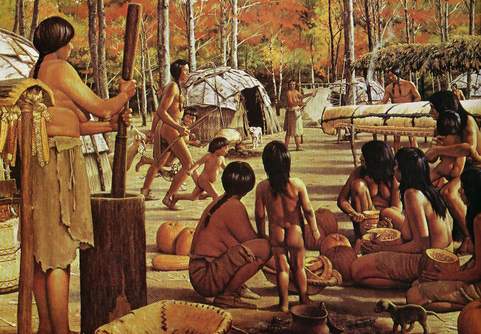Now let's compare the generic Indian lore of Joe Wright (Grey Eagle) to the actual Potawatomi lore of the region. We'll focus on seven categories of cultural knowledge mentioned by Wright.
Joe Wright
Corn, squash, and beans
Made-up Indian names
Canoes
Headdresses, feathers, and beads
Flutes and drums
Song about eagles
Parting words and handshake
Keeper’s of the Fire: The Pokagon Potawatomi Nation
A Joint Exhibition of the Pokagon Band of Potawatomi Indian Nation and the Museum at Southwestern Michigan College--June 21-Dec. 29, 2006
Food:
The Potawatomi exchanged their knowledge in canoe building with neighboring tribes for the knowledge to grow corn, beans and squash. They also grew peas, melons and tobacco. Our ancestors developed elaborate agricultural techniques. Food was dried and stored over winter, often in birch bark containers.
Women and men supplemented their diets with berries and nuts (the latter were pounded into flour for bread). The making of maple syrup and gathering of wild rice was also an important activity for the community.
Simon Pokagon, son of Chief Leopold Pokagon, in 1899 wrote in Harper’s Magazine
John R. “Dick” Winchester (1920-1973)
Potawatomi used spears to fish at night with torches of cedar soaked in pine pitch and splint baskets for holding fish.
Potawatomi with Horses--1837 (by George Winter). The Potawatomi were always willing to adopt new ways and technologies and, with the arrival of Europeans, horses became as important as canoes for transportation.
Men wore animal skins, deerskin in the summer, buffalo was prized for its warmth in the winter. Breech clothes and moccasins were also made of deerskin.
Women did the tanning of hides and wore dresses of skins. Clothing was decorated by dyeing different colors using roots and plants and embroidering designs onto the item of clothing with porcupine quills. Bird feathers were also frequently used.
Hair was worn long and in braids by women and commonly in hair locks by men. Both sexes used paint from plants to decorate their faces and bodies and men also tattooed themselves.
Beadwork--particularly after contact with Europeans, beadwork became a way of decorating clothing, containers, etc.
Basket making--black ash, sweetgrass, birch bark. After contact with non-Natives, much of it became a source of funds for families through sale to tourists. Also given as gifts and as exchange.
Pottery--hand coiled and fired, it was replaced after contact with Europeans with iron kettles and other containers.
Quill work--dyed and used to make decorations on all sorts of decorative and utilitarian items.
Tools--Potawatomi made their tools from material found around their village. Bows, hoes and dishes were made from wood. Flint was chipped to make arrowheads and used to start fires for cooking and warmth. Needles and fish hooks were carved from animal bone. Stones were used for axes and to grind corn.
Our ancestors believed in a Creator, Kishaminado. Much of our spirituality has been passed down to us generation by generation and remains private and personal. The Potawatomi retain the legacy of understanding the power of Medicine Bundles and Medicine Bags, Vision Quests, and Naming Ceremonies. Also understood are the importance of songs and dance, feasts, as well as, the use of sacred medicines provided by the Creator, such as tobacco, sage, cedar and sweetgrass.
Our language is of the Algonquin language group. Potawatomi people taught their children of the deep connection and dependence on Nokmeskignan, Grand Mother Earth, in a language with a vocabulary of over 20,000 words.
The Potawatomi language is based on describing what is happening, and when translated into English, one finds that Potawatomi is based on verbs rather than nouns or adjectives.
As you might've guessed, Potawatomi culture is infinitely more complex than the generic pap explained by Joe Wright. In some cases--the names, the headdresses, the overemphasis on flute music--Wright's "information" is almost certainly wrong. The children aren't learning about real Indians from Wright; they're learning about stereotypical Indians.
Unless a teacher is planning to skip Indians altogether, Wright's lecture sounds pretty useless. About its only value is to get students thinking about Indians rather than lunch or recess. Almost any other source of Native information would be more informative and accurate.
For more on the subject, see The Basic Indian Stereotypes.


The deity name variation on the Ojibway "Gitchemanitou" is interesting, but of course these are Algonquian languages.
ReplyDelete5:29 PM
The Bodéwadmimwen language is endangered with less than 15 fluent heritage speakers still alive...
ReplyDelete